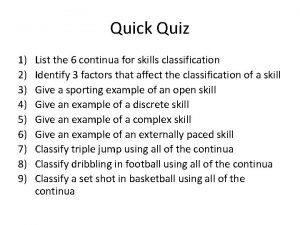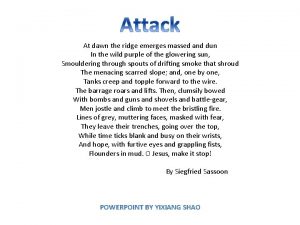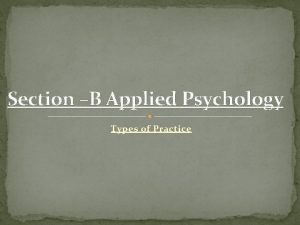Types of Practicelearner Massed practice almost continuous all







- Slides: 7

Types of Practice/learner • Massed practice (almost continuous, all at once) • Distributed practice (with rest breaks) • What type of learner is massed practice suitable for? • Experienced, older, fitter, more motivated. • What type of learner is better for distributed practice. • Beginner, less experienced, limited physical/mental preparation.

Types of practice/task • Massed practice better for which type of tasks? • Discrete or brief in nature e. g. golf shot • Simple • Distributed practice better for which type of tasks? • Continuous, requiring repetition of gross skills. E. g. swimming, running, cycling • Complex /precision orientated tasks. • dangerous

Variability of Practice • • Skills practiced in in new/different situations. Useful for open skills Helps development of schema Helps performer successfully adapt to meet the demands of the situation. Practice should be realistic to ‘real game’ situation. Practice should be meaningful. Variety of massed and distributed practice Will maintain motivation.

When to use different methods of practice (task determined) Whole method Part method Progressive part method • Low complexity or simple task • High level organisation • Interrelated subroutines • Discrete skill • Short duration • Lacks meaning in parts • Allows co-ordination of important spatial or temporal components • Complex task • Helps chaining of complex skills learned independently • Allows for attention demands to be limited • Allows for coordination of spatial/temporal components to be experienced. • Helps with transfer to whole • High level of complexity • Low level of organisation • Independent subroutines • Serial tasks • Slow tasks • Lengthy duration • Dangerous skills

When to use different methods of practice (performer) whole Part Performer is: • Experienced • High level of attention • Later stages of learning • Older • Highly motivated • Using distributed practice Performer is: • A beginner • Someone with limited attention span. • Early stages of learning. • Having problems with a specific aspect of a skill • Limited motivation • Using massed practice Part progressive

Advantages of whole and part method Whole method Part method Waste no time assembling parts. Allows serial tasks to be broken down and learned in components e. g. gym Good for quick discrete skills where a single complete action is required Reduces the demands on the learner attempting complex skills Better for time synchronised tasks if learner can cope with level of skill e. g. swimming stroke. Helps provide motivation to continue if progress can be seen to be made Learner can appreciate the end product/movement. Very important for skills which have a dangerous element. The movement retains a feeling of kinaesthetic sense Can reduce fatigue in physically demanding skills Movement easier to understand. relationship between subroutines Allows teacher to focus on particular element of skill and remedy problem. Learner can develop own schema through trial and error Provides stages of success Transfer to real situations from practice likely to be positive Good for low organisation tasks which can be broken down

Disadvantages of whole and part method Whole method Part method Ineffective with complex tasks Transfer from part to whole may be ineffective Not appropriate for dangerous tasks Highly organised skills are difficult to break down in parts Not always appropriate if group/performer of low experience Can have demotivating effect when not doing a full movement May overwhelm a performer and produce little success at first Loss of continuity / feel of flow Could lead to learner losing confidence Loss of kinaesthetic sense Time consuming Loss of awareness of end product











